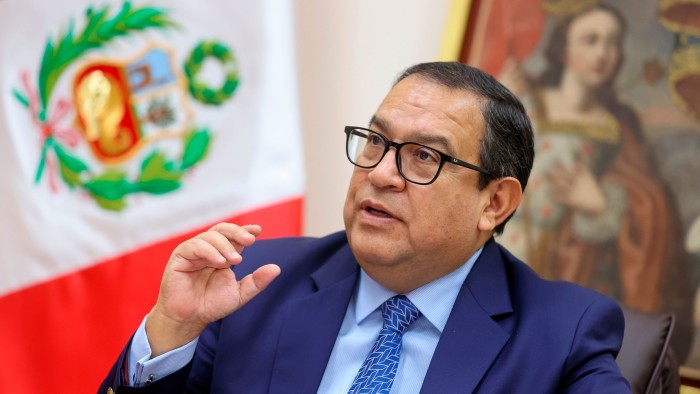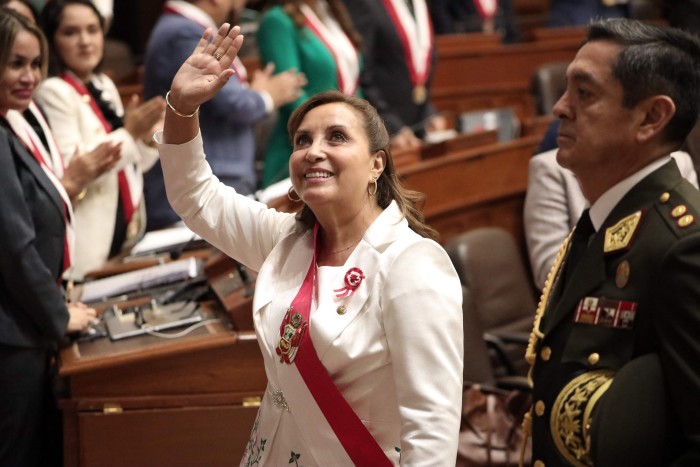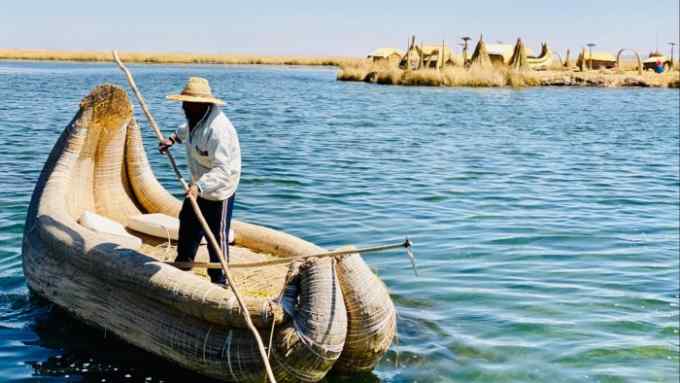Peru’s prime minister on fatal protests, renewal and reform

Roula Khalaf, Editor of the FT, selects her favourite stories in this weekly newsletter.
Some call him the real power in the land. Others credit him with bringing stability to Peru’s government at a time of crisis. Critics blame him for unleashing trigger-happy troops on protesters, with tragic consequences.
Alberto Otárola, a 56-year-old former constitutional lawyer, sees his role as prime minister in more straightforward terms. “We have been on the edge of an institutional abyss,” he says in an interview with the Financial Times, referring to the protests of last December and January, when tens of thousands of Peruvians took to the streets to demand early elections.
“I think posterity will remember President Boluarte as the president who saved democracy and the rule of law.”
Brought into the government last December, after leftwing former president Pedro Castillo was impeached over an attempt to seize extraordinary powers and suspend Congress, Otárola has become the indispensable right-hand man of Dina Boluarte, the inexperienced vice-president who succeeded Castillo.
“He is not the power behind the throne,” says a senior executive in Lima, speaking on condition of anonymity. “Quite simply, he is the power.”
Otárola is known as an able political operator — a quality essential in his role co-ordinating the Peruvian cabinet and liaising with Congress. He has close links to the military from past roles in the defence ministry. He presided over a crackdown by troops and police on protests against Boluarte’s provisional government, first as defence minister for 11 days, then as prime minister.

Forty-nine civilians were killed during the response to the protests between December 2022 and this February, according to Peru’s ombudsman’s office.
Speaking in the prime ministerial office in Lima’s colonial-era government palace, Otárola says “we have wept over those deaths” but is unrepentant about the need for firm measures to control what he says was a “very violent group which tried to seize power in the best Leninist tradition”.
“The first challenge was to pacify the country,” he says. “We managed it with a great deal of effort and today we are seeing a country in which 33mn Peruvians can fully exercise their right to peace and calm.”
Human rights groups disagree. “Peruvian military and police used disproportionate and indiscriminate force against protesters and bystanders, in clear violation of international law,” said Human Rights Watch after investigating the protests. “The vast majority of fatal victims died of gunshot wounds caused by assault rifles and handguns.”
Otárola declines to comment on the handling of the protests, citing an ongoing investigation by the prosecutor-general’s office, but says he and the government were “absolutely ready” to co-operate with the probe and wanted to see a process of national reconciliation in Peru after the divisions of recent years.
With the country relatively calm in recent months, the prime minister
is turning his attention to seeking foreign investment to boost the economy. “It’s a priority for this government to encourage private investment in infrastructure — we have a huge infrastructure gap,” he says, citing water, sanitation, health and education as priorities.
Otárola recognises that mining, the mainstay of the export economy, has suffered from delays in project approvals. He promises that the government will help unblock the multibillion-dollar projects needed to attract foreign investment and generate jobs. “Peru will win back a leading position in Latin America in mining, in agricultural exports and, above all, in public policy, which will guarantee investor confidence,” he says.
The premier also hopes to win congressional support for broader political reforms to tackle some of the endemic problems that have plagued successive governments. These include the fragmentation of political parties, the need for an elected president to win congressional approval for his cabinet, and the ill-defined condition of “moral incapacity”, which legislators can use to impeach a president.
“It may seem a little hard to say, but I believe that the conditions are right in this legislature to carry out political reform,” Otárola says. “There is a democratic bloc in Congress which has understood that the central role of Congress has to go hand in hand with political stability.”
Legislators have used the “moral incapacity” clause to impeach two presidents in the past three years: Martín Vizcarra and Castillo. A third, Pedro Pablo Kuczynski, resigned in 2018 rather than face a vote.
Otárola says that, as a constitutional lawyer, he understands “moral incapacity” to mean a president who could not govern due to mental health problems, but that the concept has been wrongly extended to cover moral or ethical issues. He hopes the government can negotiate a consensus with Congress over political reform during the next year, to put changes in place well before Peru’s presidential election in 2026.
Without reforms, he says, “if everything continues as it is now, there will be around 100 political parties registered by 2026. At the moment we are close to 30. We have to do something.”
Many Peruvians are sceptical that what is essentially a caretaker government with a fragile mandate can implement major changes before fresh presidential and congressional elections in 2026. But Otárola is bullish.
Asked what his message to foreign investors would be, he responds succinctly: “Peru is back.”

Comments